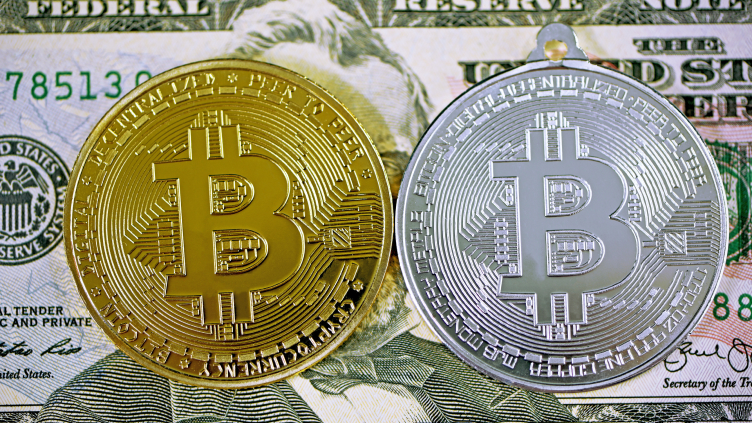Bitcoin
Inside latest crypto firm paying billions to end legal troubles

South Korean authorities are seeking the arrest of Do Kwon, co-founder and chief executive officer of Terraform Labs. His company is behind the now-collapsed terraUSD and luna cryptocurrencies. South Korean prosecutors are now seeking to freeze bitcoin linked to Kwon.
Woohae Cho | Bloomberg | Getty Images
Months before Sam Bankman-Fried and the FTX fraud was exposed, and years before Binance and its founder, Changpeng Zhao, would admit fault and settle with the U.S. for several billion dollars, Do Kwon was widely regarded as crypto’s top villain for nearly dismantling the entire sector with his failed U.S. dollar-pegged stablecoin.
It was May 2022, and Kwon was riding high. His company, Terraform Labs, was behind one of the most popular U.S.-pegged stablecoins on the planet, the venture funding was rolling in, his coins (dubbed terra and luna) were collectively worth tens of billions of dollars, and like Bankman-Fried, Kwon had landed a spot on the prestigious Forbes 30 under 30 list.
Perhaps in his greatest show of confidence in the empire he had built, just one month before it all collapsed, Kwon posted that he named his newborn daughter Luna. “My dearest creation named after my greatest invention,” he wrote.
And then it all came crashing down.
Zoom In IconArrows pointing outwards
Whereas most stablecoins are backed up by a mix of cash and other assets to match the value of tokens in circulation, Kwon’s invention was instead backed by a complex set of code. When the algorithm failed in May 2022, it cost investors $40 billion in market value overnight, led to devastating losses to multiple investors, and contributed to the collapse of hedge fund Three Arrows Capital in June 2022, followed by crypto lenders Voyager Digital, then BlockFi, then Genesis — and, in a roundabout way, FTX too.
The stablecoin’s implosion also rocked confidence in the sector and accelerated the slide in cryptocurrencies already underway as part of a broader pullback from risk.
In the years since, U.S. criminal, civil, and bankruptcy courts have been cleaning up the wreckage, in part, by prosecuting bad actors and fining fallen firms. This week, a judge signed off on Do Kwon and his bankrupt Terraform Labs settling with the U.S. Securities and Exchange Commission for $4.5 billion. This comes after a jury unanimously found Kwon and his company liable for securities fraud following less than two hours of deliberation.
How Kwon, who is currently in the Balkans — or Terraform Labs, which remains in bankruptcy and, according to court testimony, only has around $150 million in assets — will be able to pay the fine remains unclear. But it does serve as the latest example of crypto’s bad actors atoning for past sins.
Read more about tech and crypto from CNBC Pro
In April, Binance’s founder and ex-CEO was sentenced to four months in prison after settling with the U.S. Justice Department, Commodity Futures Trading Commission and the Treasury Department for $4.3 billion in November. A few weeks before that, in March, the FTX founder and ex-CEO was sentenced to 25 years in prison. Celsius CEO Alex Mashinsky starts his jury trial later this year, in September.
The washout of crypto’s previous class of tycoons comes as the digital asset market matures and gains the backing of Wall Street’s top brass.
Token prices are in the midst of a bull run, with bitcoin reaching a new all-time-high above $73,000 in March. Meanwhile, some of the biggest names in traditional finance have jumped into crypto in the last year, as firms including BlackRock and Fidelity issue billions of dollars worth of spot bitcoin exchange-traded funds in the U.S.
Here’s a rundown of where the culprits who nearly blew up crypto are today, including those who remain on the lam.
Terraform Labs’ Do Kwon
A police officer escorts Terraform Labs co-founder Do Kwon after he served a sentence for document forgery in Podgorica, Montenegro, March 23, 2024.
Stevo Vasiljevic | Reuters
Kwon is currently living in a sort of legal and social purgatory in the Balkans.
The 32-year-old fugitive is holed up in Montenegro after months on the run that involved leaving Singapore for a mix of destinations, including Dubai, Serbia, and Montenegro. He’s been there since March of last year, following a failed attempt to flee from Podgorica to Dubai on a jet with a fake passport. Do Kwon is out on bail but bound to the Balkan state, until the country’s Supreme Court decides whether to ship him back home to South Korea to face trial, or to the United States, where the former crypto tycoon has been tried in absentia and found guilty on civil charges.
As for criminal repercussions for Kwon, it all depends on what the Montenegrins decide.
U.S. judges have been coming down hard on the crypto criminals who cost retail investors tens of billions of dollars, but South Korea doesn’t plan to go easy either, with one prosecutor reportedly saying that he expected Kwon to face the longest jail term for a financial crime in the country’s history, which could top 40 years.
The crime goes back to the fall of terraUSD (UST) and its sister token luna in May 2022, which had been one of the most popular U.S. dollar-pegged stablecoin projects.
Kwon had a knack for convincing people to buy what he was selling. Most notably, he sold his vision of a new kind of payment system that would upend the status quo and replace the world’s currencies.
TerraUSD (also called UST) and its sister token, luna, moved in lockstep. UST functioned as a U.S. dollar-pegged stablecoin meant to replace global fiat transactions, while luna helped UST keep its peg and earned investors a killing as it appreciated in value. (In 2021, luna was up 15,800%.) Traders were also able to arbitrage the system and profit from deviations in the prices of the two tokens.
The setup wasn’t new. Algorithmic stablecoins, which rely on a complex set of code rather than hard currency reserves to stabilize their price, had been a thing since at least 2015 — and the idea of staking crypto to earn an unrealistically high return exploded in popularity alongside the rise of decentralized finance, or DeFi.
But Kwon had a real touch for marketing. He cast himself in the likeness of a next-gen Satoshi Nakamoto (the pseudonymous name given to the founder of bitcoin), crossed with the social media swagger of an Elon Musk.
Kwon raised $207 million for his Terraform Labs, which launched luna and UST, and an aggressive online posture, in which he shunned the “poor” (that is, luna skeptics) on Twitter, drew in the masses. He inspired an almost cult-like following of self-identifying LUNAtics — including billionaire investor Mike Novogratz, who went so far as to memorialize his membership in this club with a tattoo on his arm.
Terra’s Anchor platform, which really helped to put UST on the map with its outsized return of 20%, could have been a big red flag for savvy investors. Many analysts believed it was unsustainable. At the time, government bonds were paying around 2% and savings accounts less than 1%. But investors piled in anyway, giving luna and UST a combined market value of almost $40 billion at one point.
Overnight, both tokens plunged in value and were essentially worthless. The failure was so massive, it helped drag down the entire crypto asset class, erasing half a trillion dollars from the sector’s market cap. It also dented investor confidence in the whole space.
It was reportedly Kwon’s second failed attempt at launching an algorithmic stablecoin, though his first effort saw losses in the range of tens of millions of dollars, rather than tens of billions.
“This case affirms what court after court has said: The economic realities of a product — not the labels, the spin, or the hype — determine whether it is a security under the securities laws,” said SEC Chair Gary Gensler in a press release.
“Terraform and Do Kwon’s fraudulent activities caused devastating losses for investors, in some cases wiping out entire life savings. Their fraud serves as a reminder that, when firms fail to comply with the law, investors get hurt. Terraform and Kwon fought our efforts to investigate – taking a fight over investigative subpoenas all the way to the Supreme Court. Thankfully, with this settlement, the victims of their massive fraud will now get some justice.”
FTX’s Sam Bankman-Fried
NEW YORK, US – JANUARY 03: Sam Bankman-Fried leaves the court in New York, on January 03, 2023.
Fatih Aktas | Anadolu Agency | Getty Images
FTX founder Sam Bankman-Fried was sentenced to 25 years in prison in March for the massive fraud and conspiracy that doomed his cryptocurrency exchange and a related hedge fund, Alameda Research.
The sentence in Manhattan federal court was significantly less than the 40 to 50 years in prison that federal prosecutors wanted for Bankman-Fried, but it was much more than the five to six-and-a-half years suggested by his attorneys.
“There is a risk that this man will be in position to do something very bad in the future,” Judge Lewis Kaplan said before sentencing the 32-year-old and ordering him to pay $11 billion in forfeiture to the U.S. government.
“And it’s not a trivial risk at all,” Kaplan added.
Kaplan noted he has never heard “a word of remorse for the commission of terrible crimes” from Bankman-Fried.
The judge said that in the 30 years on the federal bench, he had “never seen a performance” like Bankman-Fried’s trial testimony.
If Bankman-Fried was not “outright lying” during cross-examination by prosecutors, he was “evasive,” Kaplan said.
“There is absolutely no doubt that Mr. Bankman-Fried’s name right now is pretty much mud around the world,” the judge said.
Jurors at trial likewise did not buy Bankman-Fried’s version of events, convicting him in November of seven criminal counts and holding him responsible for losing about $10 billion in customer money due to the securities fraud conspiracy.
Prosecutors said Bankman-Fried led a conspiracy to loot customer money to make investments, fund political donations to both Democrats and Republicans, and for his personal use, as well as to repay loans taken out by Alameda Research.
Bankman-Fried plans to appeal his conviction and sentence.
Ryan Salame, a former top lieutenant of FTX founder Sam Bankman-Fried, has been sentenced to 90 months, or seven and a half years, in prison, followed by three years of supervised release.
Three other people, who all testified against Bankman-Fried at trial, are awaiting their own sentencings after pleading guilty to criminal charges related to FTX and Alameda Research.
They are Caroline Ellison, the Alameda Research CEO who at one time dated Bankman-Fried; FTX engineering chief Nishad Singh; and Gary Wang, the co-founder and chief technology officer of FTX.
In May, the bankruptcy estate of FTX announced that almost all customers would get their money back — and more. The collapsed exchange said it has between $14.5 billion and $16.3 billion to distribute to creditors and that FTX users whose claims were $50,000 or less would receive approximately 118% of the amount of their allowed claim, according to the proposed reorganization plan.
Binance’s Changpeng Zhao
Former Binance CEO Changpeng Zhao, center, departs federal court in Seattle on April 30, 2024.
Jason Redmond | AFP | Getty Images
Binance’s billionaire founder Changpeng Zhao has reported to a low-security federal prison in Lompoc, California, according to the Bureau of Prisons website.
Zhao was sentenced to four months in prison in April after pleading guilty to charges of enabling money laundering at his crypto exchange.
The sentence handed down to the former Binance chief was significantly less than the three years that federal prosecutors had been seeking for him. The defense had asked for five months of probation. The sentencing guidelines called for a prison term of 12 to 18 months.
“I’m sorry,” Zhao told U.S. District Judge Richard Jones before receiving his sentence, according to Reuters.
“I believe the first step of taking responsibility is to fully recognize the mistakes,” Zhao reportedly said in court. “Here I failed to implement an adequate anti-money laundering program. … I realize now the seriousness of that mistake.”
In November, Zhao, commonly known as “CZ,” struck a deal with the U.S. government to resolve a multiyear investigation into Binance, the world’s largest cryptocurrency exchange. As part of the settlement, Zhao stepped down as the company’s CEO.
Though he is no longer running the company, Zhao is widely reported to have an estimated 90% stake in Binance.
The scope of his alleged crimes included willfully failing to implement an effective anti-money laundering program as required by the Bank Secrecy Act, and allowing Binance to process transactions involving proceeds of unlawful activity, including between Americans and individuals in sanctions jurisdictions.
The U.S. ordered Binance to pay $4.3 billion in fines and forfeiture. Zhao agreed to pay a $50 million fine. The SEC was noticeably absent from the joint effort by the DOJ, CFTC and Treasury against Binance and its founder.
Fallen crypto tycoons awaiting judgement
Voyager said it has roughly $1.3 billion of crypto on its platform and holds over $350 million in cash on behalf of customers at New York’s Metropolitan Commercial Bank.
Justin Sullivan | Getty Images
The fall of crypto hedge fund Three Arrows Capital, and lenders Voyager Digital and Celsius, can all be traced to the collapse of Kwon’s stablecoin project.
When 3AC’s lenders asked for some of their cash back in a flood of margin calls, the money wasn’t there. Many of the firm’s counterparties were, in turn, unable to meet demands from their investors, including retail holders who had been promised annual returns of 20%.
The three companies all went bankrupt and are currently at various stages of settling their debts, with Celsius having just emerged from bankruptcy in January.
Celsius’ ex-CEO Mashinsky faces criminal trial in the U.S. later this year, while 3AC co-founder Kyle Davies says he’s not sorry for the collapse of his fund, and has so far managed to avoid jail time altogether by bouncing around the world, unlike his co-founder, Su Zhu, who served time in a Singaporean prison.
Bitcoin
Bitcoin Will Surge to $100K After Q4, Here’s Why

Dan Weiskopf, portfolio manager at Tidal Financial Group, spoke with David Lin and discussed the future prospects of Bitcoin. The focus was on the future of Bitcoin, especially its potential to reach $100,000. The talk also touched on recent market trends, noting strong interest in Bitcoin ETFs as a possible boost to its price. Looking ahead, there is hope that more platforms will approve Bitcoin ETFs, possibly pushing its price to $100,000.
Forecasts and Volatility: The Path to New Highs
While some predict Bitcoin could go as high as $150,000 or even $1 million, Dan agrees that it needs to hit $100,000 first. Dan also acknowledged Bitcoin’s volatility, saying that large price drops of as much as 50% to 70% could happen, drawing on his experience since 2017.
“We’re going to new highs because I think partly because ETF inflows have been really strong lately. Yeah, and then I think you’ll have more platforms approving spot Bitcoin ETFs in Q4, and we’re going to go up to 100K,” he said.
Big Investors and the Transformative Power of Bitcoin
He also discussed what is persuading large investors to get in on this cycle. He mentioned two key factors. Many argue that if you haven’t invested in Bitcoin, you’re missing out, citing its strong performance over the past decade. This pressure could influence returns and client expectations.
However, he emphasized a deeper reason: if you are not embracing the transformation driven by Bitcoin and digital assets, you may face challenges. This technology has the potential to reshape industries, just as the internet revolutionized business.
“A lot of people look at Bitcoin and crypto and don’t appreciate that with higher prices comes more supply. We talk about 100K, I would expect more supply to come into the market as we go up, and that’s not really new news, but it’s higher demand that’s offsetting that supply,” he added.
Read too: It’s time tor ETH Point ETF: Here’s What to Expect From the Ethereum Price Rally
Bitcoin
Bitcoin Jumps as Markets See Increased Chances of Trump Victory

CFOTO | Future Publishing | Getty Images
Bitcoin hit a two-week high on Monday as betting markets suggested a higher chance of crypto-friendly candidate Donald Trump winning the US presidential election.
The value of the world’s largest cryptocurrency, bitcoin, was up about 5% as of 1:40 p.m. London time to $62,781.48, according to CoinGecko.
The rally follow the dramatic and failed assassination attempt about the former president Trump on Saturday.
“There is a ‘parallel’ to the assassination of President Reagan in 1981,” even though it was not an election year, Ben Emons, chief investment officer at FedWatch Advisors, said in an emailed note.
“After the incident, Reagan’s popularity skyrocketed amid a double-dip recession. The S&P 500, however, fell 9% in the aftermath due to the economic malaise. But in the current strong economy, former President Trump’s favorability is likely to skyrocket and impact markets positively.”
Investors said on the weekend they were hoping that so-called “Trump victory trades” would get a boost. These trades broadened to include several cryptocurrency stocks, such as Coinbase Global and miner Riot platformswhich rose 4.5% and 5.25%, respectively, in pre-market trading.
“Bitcoin’s price rose about 9% over the weekend, which could indicate that investors are hoping that a Trump presidency will create a more favorable regulatory climate for the crypto industry,” Zach Pandl, head of research at Grayscale Investments, told CNBC in an email.
Trump has yet to lay out any detailed proposals on cryptocurrency regulation, but the Republican candidate is now seen as broadly supportive of the sector — despite his past skepticism. He is set to speak at a major annual bitcoin conference later this month.
Trump’s campaign started accepting donations of the cryptocurrency industry in May and its the message became increasingly positive about the future of these digital assets. He also sought to position oneself against Democrats who are in favor of controlling the industry, such as Senator Elizabeth Warren.
“In addition, macro policy changes under a second Trump presidency — including continued deficit spending, reduced U.S. leadership in international affairs, weaker Federal Reserve independence, and a desire for currency weakness to help reduce the trade deficit, among other things — could introduce downside risks to the U.S. dollar in the medium term. Any downside risks to the U.S. dollar could provide support for Bitcoin’s price,” Pandl added.
Last month, analysts at Standard Chartered said that the US presidential election is the next key catalyst for bitcoin’s price and a Trump victory could push it to $150,000 by the end of the year.
“Cryptocurrencies have not had an easy time in recent months. We are currently in a crisis of previously growing capital inflows into this market that can be measured by the capitalization of stablecoins, which has frozen in the last two months,” Grzegorz Drozdz, market analyst at Conotoxia, told CNBC in an email.
With a higher likelihood of a Trump presidency and the consequent reduced chances of unrest and destabilization in the US, Drozdz now sees a potential “influx of confidence into the markets,” which could positively impact cryptocurrencies and bitcoin in the coming weeks.
Bitcoin
Germany Sells Final Bitcoin Reserves of Initial $3 Billion in Holdings

Germany Sells Final Bitcoin Reserves of Initial $3 Billion in Holdings
The German government completed the sale of its remaining Bitcoin holdings on July 12. The final transaction involved 3,846 Bitcoin, valued at around $62,604 per Bitcoin, which were sent to “Flow Traders and 139Po,” entities likely for institutional/OTC deposit services, according to for Arkham Intelligence.
The majority of the 50,000 Bitcoins sold by the German government over the past three weeks originated from asset seizures. This sale marked the culmination of weeks of increased sales activity by the German government, which unloaded tens of thousands of Bitcoins in multiple tranches. This significant liquidation was a key factor in keeping the Bitcoin selloff at a low of $54,000 on July 5.
Despite Germany’s exit from its Bitcoin holdings, market pressures remain due to Mt. Gox’s impending $9 billion repayment plan. The Mt. Gox exchange, which collapsed in 2014 when Bitcoin was still in the hundreds of dollars, has long been a source of market anxiety. The repayment plan aims to compensate creditors, potentially adding significant selling pressure to the market in the coming weeks. However, it is difficult to estimate the impact of Mt. Gox’s repayment on the markets due to several factors.
Amid heightened selling pressure, institutional investors seized the opportunity to buy the dip. Data from CoinShares showed that U.S. exchange-traded funds (ETFs) saw $295 million in inflows during the week of July 8, reversing a trend of suppressed inflows into these investment funds. This activity suggests that institutional investors remain confident in Bitcoin’s long-term prospects.
Bitcoin
Bitcoin surges as traders bet on Donald Trump election victory after shooting

Unlock the US Election Countdown newsletter for free
The stories that matter about money and politics in the race for the White House
Bitcoin surged on Monday following an assassination attempt on Donald Trump, as investors increased their bets on the former president winning the US presidential election in November.
Bitcoin’s price rose as much as 9.1 percent to $62,830, its highest level in two weeks, after a shooter hit Trump in the ear at a campaign rally over the weekend. The Republican is seen as the most pro-crypto candidate, having hosted industry executives at Mar-a-Lago and expressed enthusiasm for bitcoin mining in the U.S.
Trump’s campaign also accepted cryptocurrency payments, a first for a major U.S. political party, raising hopes of an end to the U.S. regulatory crackdown on the sector seen in recent years.
“The probability of a Donald Trump victory has increased significantly,” said Grzegorz Dróżdż, market analyst at exchange firm Conotoxia, adding that a Trump presidency would have a “positive impact” on cryptocurrencies.
Shares of Trump’s Truth social media company jumped 60 percent in premarket trading. Trump Media & Technology Group went public in March in a merger with a blank-check company and rallied ahead of the debate between Trump and President Joe Biden last month.
The slimmer chances of a second Trump presidency were also felt in broader financial markets. U.S. Treasury yields and the dollar rose in a more muted version of the reaction that followed Biden’s disastrous debate performance.
Many investors believe Trump’s tax-cutting policies would increase deficits and inflation, hurting U.S. Treasuries and boosting the dollar, in a pattern similar to what occurred after his 2016 election victory.
The U.S. dollar index, which tracks the greenback against a basket of six other major currencies, rose 0.2% in morning trade, having weakened so far in July as investors increased their bets on a September interest rate cut by the Federal Reserve.
Yields on benchmark 10-year Treasuries rose 0.03 percentage point to 4.21 percent, reflecting a small decline in price. Contracts tracking Wall Street’s blue-chip S&P 500 and the tech-heavy Nasdaq 100 rose 0.3 percent and 0.5 percent ahead of the New York open.
Monday’s movements “touch[s] with a Trumpian theme given the popular narrative that he is good for business and… his pro-crypto stance,” Rabobank analysts said in a note to clients.
“For markets, the complexities of the US political landscape have boiled down to the assumption that the weekend’s events will lead to a greater chance of Trump winning the November presidential election,” they added.
Bitcoin peaked above $70,000 in mid-March but has struggled to make headway since the so-called halving event in April, when the number of daily bitcoins available for miners to share to secure the bitcoin network fell from 900 to 450. Some analysts had expected bitcoin to rebound after the halving.
-

 News1 year ago
News1 year ago“Captain Tsubasa – RIVALS” launches on Oasys Blockchain
-

 Ethereum1 year ago
Ethereum1 year agoComment deux frères auraient dérobé 25 millions de dollars lors d’un braquage d’Ethereum de 12 secondes • The Register
-

 News1 year ago
News1 year agoSolana ranks the fastest blockchain in the world, surpassing Ethereum, Polygon ⋆ ZyCrypto
-

 Videos1 year ago
Videos1 year agoHistoric steps for US cryptocurrencies! With a shocking majority vote!🚨
-

 Videos1 year ago
Videos1 year agoIs Emorya the next gem💎 of this Bitcoin bull run?
-

 News1 year ago
News1 year agoSolana Surpasses Ethereum and Polygon as the Fastest Blockchain ⋆ ZyCrypto
-

 Videos1 year ago
Videos1 year agoNexus Chain – Ethereum L2 with the GREATEST Potential?
-

 Ethereum1 year ago
Ethereum1 year agoScaling Ethereum with L2s damaged its Tokenomics. Is it possible to repair it?
-

 News1 year ago
News1 year agoFnality, HQLAᵡ aims to launch blockchain intraday repositories this year – Ledger Insights
-

 Regulation1 year ago
Regulation1 year agoFinancial Intelligence Unit imposes ₹18.82 crore fine on cryptocurrency exchange Binance for violating anti-money laundering norms
-

 Bitcoin1 year ago
Bitcoin1 year agoBitcoin Drops to $60K, Threatening to Derail Prices of Ether, Solana, XRP, Dogecoin, and Shiba Inu ⋆ ZyCrypto
-

 Videos1 year ago
Videos1 year agoRaoul Pal’s Crypto Predictions AFTER Bitcoin Halving in 2024 (The NEXT Solana)





















